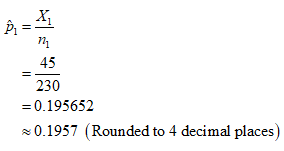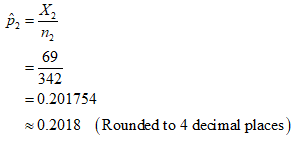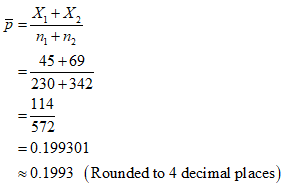A student pursuing a degree in English as a second language believes the proportion female factory workers who can't speak English is different than the proportion of male factory workers who can't speak English. To test her claim she randomly selects 230 female factory workers and out of them 45 could not speak English. She then randomly selects 342 male factory workers and out of them 69 could not speak English. Test her claim at αα=0.05 to see if she was right. The correct hypotheses are: H0:pF≤pMH0:pF≤pM HA:pF>pMHA:pF>pM(claim) H0:pF≥pMH0:pF≥pM HA:pF
A student pursuing a degree in English as a second language believes the proportion female factory workers who can't speak English is different than the proportion of male factory workers who can't speak English. To test her claim she randomly selects 230 female factory workers and out of them 45 could not speak English. She then randomly selects 342 male factory workers and out of them 69 could not speak English. Test her claim at αα=0.05 to see if she was right. The correct hypotheses are:
- H0:pF≤pMH0:pF≤pM
HA:pF>pMHA:pF>pM(claim) - H0:pF≥pMH0:pF≥pM
HA:pF<pMHA:pF<pM(claim) - H0:pF=pMH0:pF=pM
HA:pF≠pMHA:pF≠pM(claim)
Since the level of significance is 0.05 the critical value is 1.96 and -1.96
The test statistic is: (round to 3 places)
The p-value is: (round to 3 places)
The decision can be made to:
- reject H0H0
- do not reject H0H0
The final conclusion is that:
- There is enough evidence to reject the claim that the proportion female factory workers who can't speak English is different than the proportion of male factory workers who can't speak English.
- There is not enough evidence to reject the claim that the proportion female factory workers who can't speak English is different than the proportion of male factory workers who can't speak English.
- There is enough evidence to support the claim that the proportion female factory workers who can't speak English is different than the proportion of male factory workers who can't speak English.
- There is not enough evidence to support the claim that the proportion female factory workers who can't speak English is different than the proportion of male factory workers who can't speak English.
From the given information, let X1 be the female factory workers that could not speak English. X1 = 45.
Let X2 be the male factory workers that could not speak English. X2 = 69.
Let n1 be the total female factory workers. n1 = 230.
Let n2 be the total male factory workers. n2 = 342.
Level of significance 
Claim: The proportion of female factory workers who can’t speak English is different that the proportion of male factory workers who can’t speak English.
The null and alternative hypotheses are,

Compute the values of  .
.


Compute the values of  .
.


Step by step
Solved in 4 steps with 13 images









